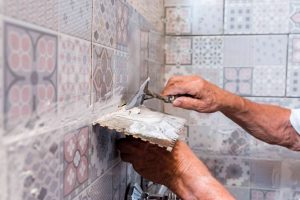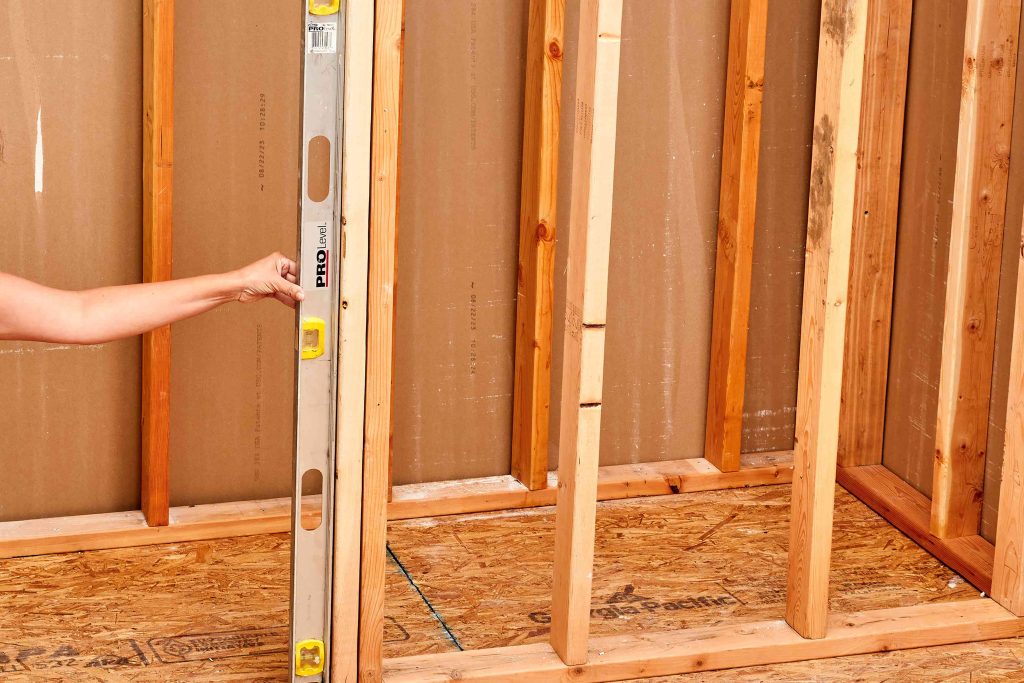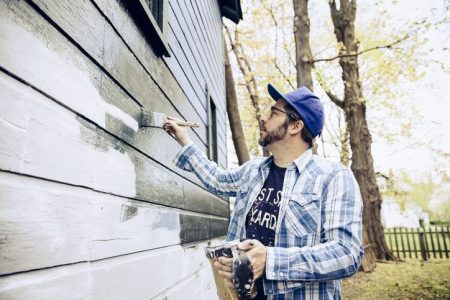Framing a wall—or building a basic wall—is a basic skill that will help you change the footprint of your home in substantial ways. Framing is a simple, inexpensive project that doesn’t require many specialized tools or materials: just a framing hammer, nails, and two-by-fours. Once you have framed the wall, you’re all set to add doors, windows, siding, or drywall.
Basic Components of a Wall
A framed wall is a simple yet flexible design. Precise placement of the studs horizontally and vertically is what makes the design so strong.
Bottom Sole Plate (Horizontal)
The entire framed wall rests on one bottom sole plate made of a two-by-four. This two-by-four runs horizontally and rests on the floor.
When framing a wall on concrete, the wall’s bottom plate must be made of pressure-treated wood to prevent moisture from decaying the wood.
Studs (Vertical)
Seven vertical two-by-four studs per 8 feet of wall run perpendicular to the bottom plate. At the top, they will connect with the top plates. Wall studs should be framed 16 or 24 inches apart according to the local code and the requirements of the project. Generally, it’s safest to space the studs every 16 inches.
Top Plates (Horizontal)
Paralleling the bottom plate are two top plates, also two-by-fours. This plate connects to the tops of the vertical studs and to the ceiling.
Safety Considerations
If framing the wall also involves removing another wall, be sure to create a support system prior to removing the wall. Use adjustable steel columns (also called lally columns or jack posts) with two-by-fours above and below the steel columns, or you can build a temporary wall from two-by-fours.
What You’ll Need
Equipment / Tools
- Framing hammer
- Speed Square
- Pencil
- Chalk line
- Electric miter saw or circular saw
- Powder-actuated nailer (for concrete floors)
- Safety glasses
Materials
- 10 premium two-by-fours, each 8-foot
- 16d (3 1/2-inch) nails
Instructions
How to Frame a Wall
-
Plan Project
A framed wall requires vertical studs every 16 inches (or 24 inches, in some cases) and two top plates and one bottom plate. For large projects, calculate the number of materials with an online calculator or manually.
Prepare a large section of floor to work on. The floor should be perfectly flat. Some walls can be built and installed after finishing, but other interior projects may require you to frame the wall in place. If your ceilings or floors are not level, it’s best to frame the wall in place by measuring each wall stud for the specific height of its intended location.
-
Stack Plates
Choose the two-by-fours that you intend to be the wall’s plates. Lay them on edge, side-by-side. With the square, make sure that the ends are perfectly lined up.
-
Mark Center Stud Locations on Plates
Hook the end of the tape measure on one end of the stacked plates. Run the tape measure the entire length of the plates to the end and lock it in place. With the pencil, mark every 16-inch increment on the stud until you reach the end of the board. With the Speed Square, run the mark across both plates.
These are the on-center locations for each vertical stud. Do not remove the tape measure.
-
Mark Front Edge Stud Locations
To make it easier to place the vertical studs, mark the front edge of where each one will begin. To do this, mark backward 3/4 inch from each of the previous on-center marks.
So, an on-center measurement of 16 inches would also be marked backward to 15 1/4 inches. Leave the on-center marks in place but “X” them out to avoid confusion.
On-Center Front Edge of Stud 16 inches 15 1/4 inches 32 inches 31 1/4 inches 48 inches 47 1/4 inches 64 inches 63 1/4 inches 80 inches 79 1/4 inches 96 inches 95 1/4 inches Continue Measurements to Face
Rotate the two-by-fours a quarter-turn each so that they are now laying flat. With the Speed Square and pencil, continue the edge marks across the faces.
Cut Studs
Using the electric saw, cut the vertical studs to the desired height of the wall, minus the thickness of the three plates. So, if you would like your wall to be 8 feet high, cut the studs to 91 1/2 inches long (96 inches minus 4 1/2 inches).
Dry-Fit Studs and Plates
Loosely lay out the stud wall with the two-by-fours on edge, with two plates on top and one at the bottom. Sight down each of the vertical studs to determine the crown or curvature direction. Lay each stud with the crown facing upward. If any stud’s crown differs from that of the other studs, remove it from this project.
Step Back Top Plate for Corners (Optional)
If this is a single wall, align the two top plates one on top of the other. If, instead, the wall will join 90 degrees to another wall that you are framing, step back the topmost plate.
Leave the lower of the two top plates full length. The plate that rests on top of that plate should be cut 3 1/2 inches shorter. So, if the lower top plate is 96 inches, the plate on top of that should be 92 1/2 inches. This allows the adjoining corner wall to interlock at the top.
Attach All Pieces
Nail the studs into place between the top and bottom plates, using two nails per end. If you are attaching the topmost top plate at this time, nail it into place above every vertical stud location.
Raise Wall
Snap a chalk line on the floor where you want the wall frame to run. With an assistant, tilt the wall frame up and move it into place along the chalk line.
Attach Corner
If the wall will meet up with another framed wall at a corner, butt them up against each other to form an L-shape. Drive nails about every 24 inches down the two adjoining boards. When joining two new walls at a corner that have not been installed yet, tie walls together by using construction ties for framing.
Attach to Floor
For wood subfloors with joists, nail the wall frame through the bottom plate to the floor with two nails at every available joist. Joists are not visible. They are located under the subfloor. Nail between the joists, too, wherever possible.
If the floor is concrete, use a powder-actuated nailer to attach the bottom plate to the concrete.
Warning
For wood subfloors, check underneath ahead of time to see where you will be nailing to prevent piercing electrical wires or pipes. Generally, neither service will be located directly under the subfloor within reach of nails—but it’s always safest to check.
Tips for Framing a Wall
- If the wall will continue straight for a long run, multiple wall units will need to be attached to each other. If so, attach the topmost top plate at the end, stepping it back by four feet. The best way to accomplish this is to leave the topmost plate unattached until the framing is up and in place. Then, run full-size two-by-fours across every wall break, centering them over each break at their mid-points.
- Be meticulous when measuring and marking the stud locations on the plates. When you later install sheet goods, such as plywood or drywall, these materials depend on hitting precisely aligned studs.
- If the wall frame will have windows and doors, build these in while framing rather than adding them retroactively. Frame a wall with a door or window by marking its place first, then installing the remaining wall framing around it.
- For small installations such as a shed, it can be beneficial to install the sheathing on the wall frame while the frame is still flat on the ground. The sheathing will help you force the wall frame into square.
- When attaching the top plates, nail only over stud locations. If you nail between studs, it’s more difficult for electricians and plumbers to drill holes in the plates.
- Frame an interior wall corner by nailing an additional two-by-four on the back to provide an attachment surface for the edge of the drywall.
When to Call a Professional
Small interior installations that will not bear weight from above are ideal for do-it-yourselfers. Large-scale wall framing projects, especially those that involve exterior walls, are often best left in the hands of professional framers or carpenters.
Permits and Codes
Most communities will require you to apply for a building permit before building a wall. When you check with your permitting department, wall framing may fall within the scope of a larger project such as converting a garage to living space. Or, it may come under the broad designation of changing the interior space, either structurally or non-structurally.
In any case, whether the wall you are framing will be load-bearing or not (such as in the case of a partition wall), most likely you will need a building permit and related inspections.
FAQ-
What size nails are used for framing?
Interior walls are typically framed with 3 1/2-inch nails. At your local hardware store, you can find the correct option labeled as 16d framing nails.
-
Is it better to frame with nails or screws?
Screws should not be used for framing, and many building codes require the use of nails. Nails are less likely to break over time.
-
Why are studs 16 inches apart?
Wall studs can be either 16 or 24 inches apart, though most commonly, the studs in your home will be 16 inches apart. Building materials are usually either 4 or 8 feet wide, so 16-inch spaces allow materials like drywall to land evenly on the centers of studs.
Read the full article here














